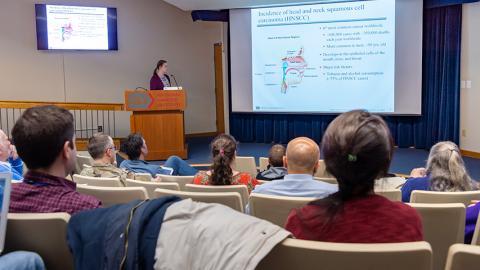
Amy Funk, Ph.D., presents her research at the NICBR Winter Symposium.
Attendees packed the Building 549 Conference Center for the National Interagency Confederation for Biological Research (NICBR) Winter Symposium, the latest in a series that aims to foster collaboration between its eight member agencies. Each symposium focuses on a specific theme, with the most recent event organized around novel therapeutics.
Julie Dyall, Ph.D., a virologist from the National Institute of Allergy and Infectious Diseases, made the introductory remarks and then ceded the podium to Craig Thomas, Ph.D., National Center for Advancing Translational Sciences (NCATS), for the keynote address.
Thomas focused on the current government environment, particularly “pessimism directed towards the government, and the concern about where tax dollars go.” In such times, he believes it is especially important to “disseminate information and dispel the mystery surrounding what those tax dollars help us do, and how it helps the public… because I can’t think of anything more important than the work that we do here.”
The National Cancer Institute (NCI) was well-represented at the symposium, with five scientists presenting their research:
- Stuart Le Grice, Ph.D. - small molecule targeting of cellular and viral RNAs.
- Amy Funk, Ph.D. - leucine zipper-bearing kinase as a novel therapeutic target in head and neck squamous cell carcinoma patients with 3q amplification.
- Pedro Torres-Ayuso, Ph.D. - TNIK, a novel druggable dependency in lung squamous cell carcinoma.
- Julio Valencia, Ph.D. - the blockade of the cross-regulation of IFNg and IL-27 limits immunotherapy-induced immune-related adverse events in a murine model of systemic lupus erythematosus.
- Curtis Henrich, Ph.D. - the discovery of natural product modulators of Merkel Cell Carcinoma cell viability.
The presentations highlighted what can be accomplished when disparate agencies pool their resources and work toward a common goal.
For example, Dr. Funk’s team worked with numerous people at the NCI, including Dr. Thomas; Matthew Hall, Ph.D.; and Dr. Kanny Wan, Ph.D.; as well as the proteomic and mouse facilities on the Frederick campus. Her team has also started a new research project with Rolf Swenson, Ph.D., at the National Heart, Lung, and Blood Institute.
“Our lab works primarily on biochemistry techniques, and we are fortunate to work with excellent chemists that synthesize compounds for us, as well as biologists who perform mouse experiments to evaluate the clinical relevance of a specific drug treatment,” Funk said.
These collaborations are essential for progressing her team’s research quickly and efficiently, and it’s one of the many reasons why she decided to join the NIH family. She urges others to take advantage of the various experts at the NIH to help advance their research projects.
Howard Young closed out the symposium by noting the diversity and uniqueness of the work that takes place across the NICBR agencies.
“I hope that it inspires all of you to take advantage of the resources here and collaborate with the entities present here,” he said, “because this meeting shows what can be accomplished by working together and collaborating on various projects.”

